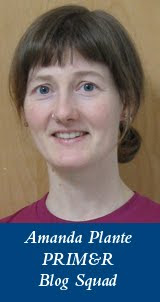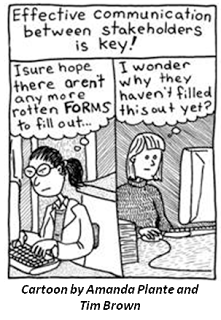 by Amanda Plante, PRIM&R Blog Squad member
by Amanda Plante, PRIM&R Blog Squad member
PRIM&R is pleased to bring you the first live posts from the 2011 IACUC Conference and the PRIM&R Blog Squad. The Blog Squad is composed of members who are devoted to blogging prior to, live from and after the PRIM&R’s conferences. Read on to find out what’s happening on the ground in Chicago, IL.
Greetings from the 2011 IACUC Conference! As a member of the PRIM&R Blog Squad for this conference, I’m pleased to provide you with a post regarding Essentials of IACUC Administration, one of the pre-conference programs offered in advance of the conference.
All participants in the workshop received a thick manual with copies of the presentation slides and lots of additional resource materials. I am sure this will serve as handy reference information as I reflect back on the workshop discussions. Essentials of IACUC Administration is coordinated by Molly Greene, BA, CPIA; Marky Pitts, CPIA; and MJ Shepherd, DVM, CPIA – three very experienced IACUC advisors and coordinators who are sharing their words of wisdom with IACUC coordinators, chairs, and other committee members. This workshop consists of eight modules that cover the full breadth of IACUC administration. On the first day, we reviewed organizing an animal care and use program and managing semiannual reviews and inspections.
Additionally, the role of the institutional official, the IACUC, the attending veterinarian, and the principal investigator were detailed. It was suggested that the freely available OLAW pamphlet What Investigators Need to Know about the Use of Animals might be a valuable resource for new investigators. This information, when combined with an institution-specific handout covering the IACUC policies and guidelines, can be utilized to help faculty better understand their responsibilities.
Elements of effective team leadership including planning, communication, management and assessment were also discussed. Communicating effectively means listening, questioning, and relating. It is essential to recognize the needs of a principal investigator and to engage them in the process of helping to find solutions.
For the latter part of the afternoon, we broke into smaller groups based on our administrative roles. The session I attended was aimed at IACUC administrators working at academic institutions. The group was led by Monte Matthews, BA, CPIA, from the University of Oregon. He led an interactive discussion based on a number of questions that attendees had previously provided to the workshop organizers. We covered topics ranging from how to better engage IACUC members (perhaps through the use of annual report cards, or the IACUC chair specifically calling upon members for comments during meetings), to how various institutions handle delegated member review (DMR).
One idea with respect to workflow was to incorporate a white board outlining the triage needed to track the progression of protocols through the review process. Other institutions use spreadsheets whereas those using online electronic systems (e.g. IRBNet, Click Commerce, TOPAZ) already have this functionality built into the system. Microsoft SharePoint is currently being used by other institutions; it was suggested this could be an intermediary process until an institution has the financial resources in place to move to a fully online system. The group discussed the requirement to confirm congruency between protocols and grant applications. I thought the use of a “congruency letter,” where the principal investigator signs to confirm that the procedures described in the animal use protocol are consistent with what is proposed in the grant, was interesting. This signed sheet would then be filed with the protocol.
One the second day of the course we covered managing protocol review; policies, procedures, and databases; post-approval monitoring (PAM); qualifications, training, and occupational health programs; and the role of IACUC administration. I especially enjoyed the presenters’ use of real-life situations to illustrate common challenges. It helps to reaffirm what one is already doing, but also allows one to consider how to better respond to situations in the future.
With regard to PAM, it is often best to target high-risk areas and principal investigators with a history of non-compliance. (While your institution may use a ‘random’ draw for determining which animal use protocols are monitored, specific principal investigators may be entered into the draw more frequently). PAM visits (especially initial visits) should emphasize education and training to ensure visits are non-threatening and collegial.
On a side note – the sitting, thinking, and discussing at these conferences can certainly build up an appetite (especially if you have been awake since 4:30 AM to catch a flight from Saskatoon!). Last evening, I had dinner at the Indian Garden which is within easy walking distance from the hotel. I had a great vegetarian meal, and would definitely recommend it if you enjoy East Indian cuisine. The concierge in the front lobby has a list of local restaurants, as well as maps of the immediate area, that as a first-time visitor to Chicago, I found very helpful.
Also, I was excited to see in the conference agenda that there are two yoga sessions planned for Thursday and Friday mornings from 6:00 to 7:00 AM. Even though I’m not really a morning person—what better way to get the blood flowing than with a few sun salutations before the conference begins!
As a reminder, at the conference I am wearing a red PRIM&R Blog Squad t-shirt. Please feel free to introduce yourself; I would love to chat with you!
Namaste, Amanda (Yoga Mom and IACUC coordinator)

No comments! Be the first commenter?